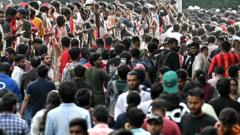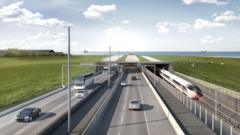Across India, pedestrians encounter a myriad of obstacles on poorly maintained footpaths, prompting citizen initiatives aimed at advocating for better walking conditions and infrastructure that supports safe, accessible transport.
The Walking Dilemma: Navigating India's Challenging Footpaths

The Walking Dilemma: Navigating India's Challenging Footpaths
A look into the struggles faced by pedestrians in Indian cities as citizen activists work towards pedestrian-friendly infrastructure.
In Indian cities, the act of walking can resemble an obstacle course rather than a leisurely stroll. If you ask a pedestrian in bustling urban locales about their walking experience, they might find it hard to count the number of challenges they face daily—though most will agree that footpaths are often in disrepair. This insight comes from Arun Pai, a passionate advocate for pedestrian rights and the founder of Bangalore Walks. Pai's recent initiative, the "world's longest footpath run," encouraged participants in Bengaluru to walk an 11-kilometer stretch, documenting their encounters with hazards like vendors, litter, and cracked concrete. Participants rated their footpath experience on a one to five scale, providing tangible evidence to present to local authorities.
Pai represents a larger movement of citizen activists striving to promote pedestrian-friendly environments in India. In the capital, for example, a cycling advocacy group called Delhi by Cycle is pushing for similar improvements, urging officials to reimagine urban infrastructure. However, in many metropolitan areas, adequate footpaths are a rarity. They are frequently overtaken by vehicles, encroaching vendors, and even the homeless, transforming what should be peaceful walkways into chaotic passages.
A recent 'pedestrian manifesto' published by the Walking Project in Mumbai highlights these issues, pushing local politicians to recognize and address the neglect faced by this often-overlooked demographic. According to statements from Vendant Mhatre, this initiative is crucial as nearly half of Mumbai's inhabitants rely on walking as their primary mode of transportation, a stark contrast to the 11% who depend on private automobiles.
Despite pedestrian fatalities ranking second among road accident casualties—over 10,000 such deaths recorded on highways in 2022—policies largely favor drivers. Experts like Mhatre criticize short-term fixes such as speed bumps, insisting that what is truly essential are comprehensive, well-planned pathways that cater to the needs of a diverse populace.
Research conducted in Chennai underscores the advantages of improving walking infrastructure; new footpaths resulted in a 9% to 27% increase in pedestrian activity, thus contributing to environmental, economic, and social welfare. However, there remains a knowledge gap: many locals lack a standard for footpath quality because they haven't experienced better pedestrian amenities elsewhere.
Prominent voices like civil engineer Geetam Tiwari emphasize that the primary focus often remains on catering to motor vehicle traffic, leading to the reduction or elimination of footpaths. This oversight not only complicates public transport access but also aggravates urban congestion issues. Tiwari advocates for a shift in mindset that prioritizes pedestrian infrastructure, noting that a sustainable solution to traffic congestion requires a commitment to creating robust pedestrian networks.
As the discussion surrounding urban infrastructure evolves, many are calling for states to adhere to guidelines set forth by the Indian Road Congress and to create Non-Motorised Transport Policies (NMTPs) tailored for pedestrians and cyclists. While some cities are leading the way, experts assert that broader acceptance and implementation of these policies across India is essential for creating a more walkable and inclusive urban environment.





















